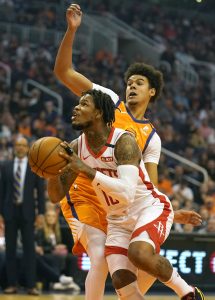The NBA’s salary cap primarily serves as a way to restrict the amount a team can invest in player salaries in a given year. However, because the league has a soft cap rather than a hard cap, there’s technically no specific figure that clubs are prohibited from exceeding once they go over the cap to re-sign players. As long as a team doesn’t use certain exceptions or acquire a player via sign-and-trade, that team doesn’t face a hard cap.
There is, however, a specific threshold on the lower end that teams must meet in each NBA season. The league’s minimum salary floor requires a club to spend at least 90% of the salary cap on player salaries. For instance, with the 2019/20 cap set at $109,140,000, the salary floor for this season is $98,226,000.
If a team finishes the regular season below the NBA’s salary floor for that league year, the penalties levied against that team aren’t exactly harsh — the franchise is simply required to make up the shortfall by paying the difference to its players. For example, if a team finished this season with a team salary of $95,226,000, that team would be required to distribute that $3MM shortfall among its players.
The players’ union determines how exactly the money is divvied up — most recently, players who spent at least 41 games on a team’s roster have received a full share, while players with between 20-40 games on the roster receive a half share. A player can’t exceed his maximum salary as a result of a shortfall payment.
For the purposes of calculating whether a team has reached the minimum salary threshold, cap holds and international buyouts aren’t considered, but players who suffered career-ending injuries or illnesses are included in the count, even if they’ve since been removed from the club’s cap. For instance, the NBA permitted the Bulls to remove Omer Asik‘s $3MM cap charge from their 2019/20 cap, but that figure would still count toward their salary floor for this season.
Additionally, the NBA made a change in its most recent Collective Bargaining Agreement to prevent teams from circumventing certain rules to reach the salary floor. Under the old CBA, a team that was $8MM below the salary floor could trade a player earning $4MM for a player earning $12MM halfway through the season and be in accordance with minimum team salary rules.
Under the current CBA, only the salary the team actually pays the player counts for minimum team salary purposes. For instance, in the example above, the team would be credited with having paid its original player $2MM for the first half of the season and its new player $6MM for the second half. In that scenario, the club would still be $4MM shy of the salary floor.
No team is at risk of falling below the salary floor for the 2019/20 season. In fact, no team is even close — every club except the Hawks used up all its cap room prior to start of the regular season, and a series of in-season trades pushed Atlanta over the cap as well. Even when they were under the cap earlier in the season, the Hawks still had a team salary exceeding the $98,226,000 floor.
Note: This is a Hoops Rumors Glossary entry. Our glossary posts will explain specific rules relating to trades, free agency, or other aspects of the NBA’s Collective Bargaining Agreement. Larry Coon’s Salary Cap FAQ was used in the creation of this post.
An earlier version of this post was published in 2018.
 Ben McLemore
Ben McLemore